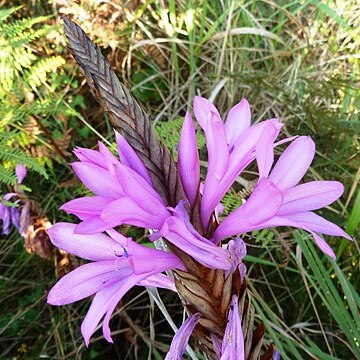Plants 600-1200(-1500) mm high, growing in clumps. Corm subglobose, 30-50 mm diam.; tunics coarsely netted, extending into a fibrous collar. Stem inclined below then erect, simple. Leaves 4 or 5, lower 2 or 3 basal, usually ± half as long as spike or rarely reaching to base of spike, linear to narrowly lanceolate, 10-15(-18) mm wide, midrib and margins lightly to moderately thickened and hyaline, uppermost leaf or leaves partly sheathing; bract-like cauline leaves 3 or more, tightly sheathing. Spike densely 30-to 42-flowered, internodes 4-6(-8) mm long; bracts dry and brown, often greenish straw-coloured with darker brown margins, with evident pale netted veins, 22-25(-28) mm long, clasping stem in lower half, strongly overlapping, apiculate to attenuate, inner shorter and concealed, forked apically for at least 2 mm. Flowers zygomorphic, weakly bilabiate, bright pink (rarely white), often with darker median streak in basal half of tepals; perianth tube with lower part 12-18 mm long, upper part ascending and funnel-shaped, 9-12 mm long, 8 mm diam. at mouth; tepals lanceolate, 18-24 x 7-9 mm, upper three spreading and lower three nearly horizontal. Filaments unilateral and arcuate, 10-12 mm long, included in tube; anthers 9-11 mm long, whitish to mauve or violet. Style arching over stamens, dividing near anther apices, branches ± 6 mm long. Capsules narrowly ovoid, 10-12 mm long. Seeds elongate-angular, with rudimentary distal and proximal wings, 4-5 x 2 mm.
More
Perennial herb, geophyte, 0.6-1.5 m high; corm tunics brown, coarsely reticulate; stem inclined below, simple. Leaves lanceolate to linear, 10-18 mm wide, margins and midrib thickened. Bracts strongly imbricate, dry and brownish, apiculate to attenuate, inner apically forked. Inflorescence a dense spike; flowers pink, rarely white, with dark pink streak in lower midline of each tepal, nearly bilabiate; tepals broadly lanceolate, apiculate; upper 3 ascending; lower horizontal. Stamens unilateral, included, arcuate to horizontal below upper tepal; filaments 10-12 mm long; anthers 9-11 mm long, unilateral, pale to whitish. Ovary oblong; style arching over filaments. Flowering time Jan.-Dec. Capsule narrowly ovoid.
A herb. It is a corm or bulb plant.

